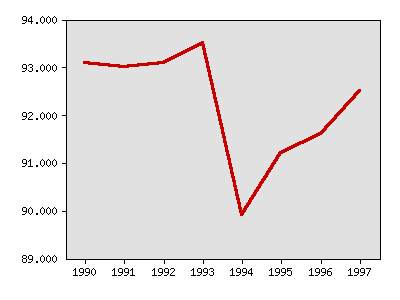What were things like in 2002?
The following idicator summary is from the 2002 Minnesota Milestones and does not neccessarily reflect the current data trends.Indicator : Availability of full-time work
Rationale: This indicator measures opportunities for workers who seek full-time employment.
About this indicator: Minnesotans' ability to find full-time work remained high throughout the decade, fluctuating between 90 and 93 percent. The data for this indicator comes from an annual survey that measures the availability of full-time work for individuals who want to work full time. Minnesota's strong economy during most of the 1990s provided full-time work opportunities for most people who sought full-time employment.
Percentage of adults who want to work full time who actually work full time

| Year | Data |
|---|---|
| Percentage of adults who want to work full time who actually work full time, U.S. Bureau of Labor Statistics | |
| 1990 | 93.1% |
| 1991 | 93% |
| 1992 | 93.1% |
| 1993 | 93.5% |
| 1994 | 89.9% |
| 1995 | 91.2% |
| 1996 | 91.6% |
| 1997 | 92.5% |
| 1998 | S |
| 1999 | S |
For comparison: In 1999, 92 percent of workers in the United States who desired full-time work were able to find it. This is the same as Minnesota's rate in 1997, the last year for which data is available.
Things to think about: Despite a proliferation of part-time jobs, a high percentage of people wanting full-time work were able to find it throughout the 1990s. Full-time jobs are often preferred because they are more likely to include health insurance and retirement benefits. Yet, some people, such as students, parents or retirees, prefer part-time jobs because of the flexibility they afford.
Technical notes: Due to historically low unemployment rates in 1998 and 1999, some survey sample data were not statistically significant enough to be released. Therefore, Minnesota figures could not be calculated for 1998 and 1999. Due to changes in the survey methodology in 1994, earlier data is not directly comparable to figures for 1994 and beyond.
Sources:U.S. Department of Labor, Bureau of Labor Statistics, Current Population Survey, Geographic Profiles of Employment and Unemployment, provided by the Minnesota Department of Economic Security, www.mnworkforcecenter.org
Related 2002 Milestones indicator:
Other related indicators:
- Unemployment rate (Minnesota Department of Economic Security, www.mnworkforcecenter.org)
Local data:





